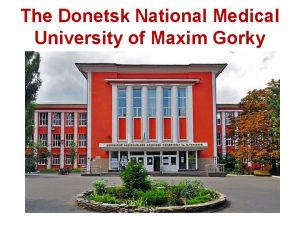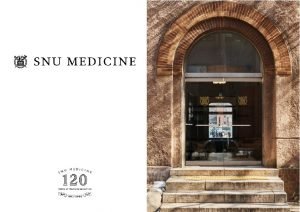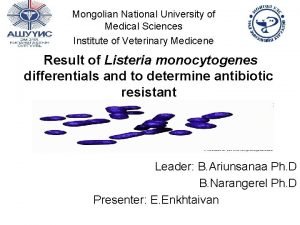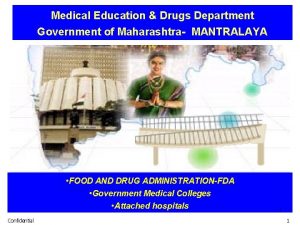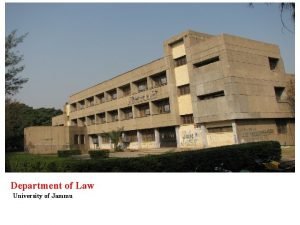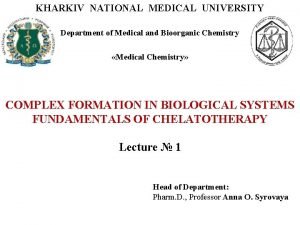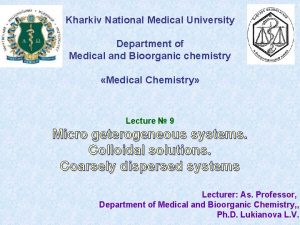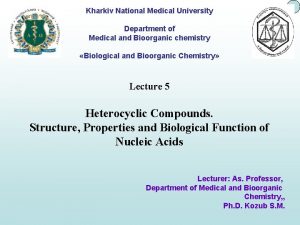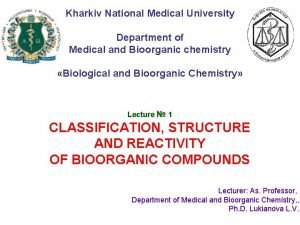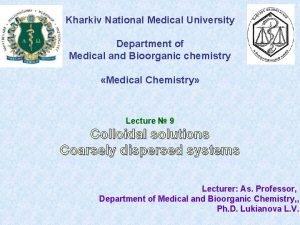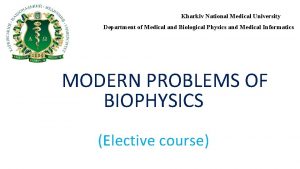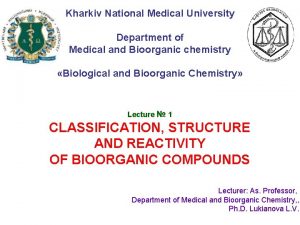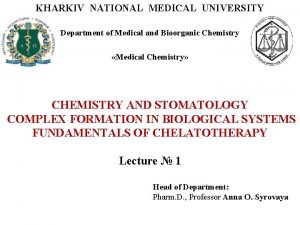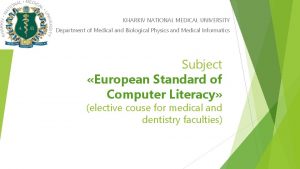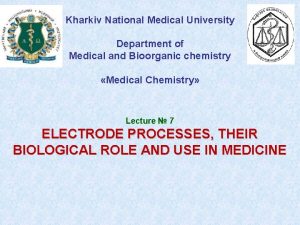KHARKIV NATIONAL MEDICAL UNIVERSITY Department of Medical and




![STRUCTURE OF COMPLEX COMPOUND complex ions of the outside sphere K 3[Fe(CN)6] complexing agent STRUCTURE OF COMPLEX COMPOUND complex ions of the outside sphere K 3[Fe(CN)6] complexing agent](https://slidetodoc.com/presentation_image_h/2ca5ff0a3edec9f46c526d9d0aeaf933/image-5.jpg)






- Slides: 11

KHARKIV NATIONAL MEDICAL UNIVERSITY Department of Medical and Bioorganic Chemistry «Medical Chemistry» COMPLEX FORMATION IN BIOLOGICAL SYSTEMS FUNDAMENTALS OF CHELATOTHERAPY Lecture № 1 Head of Department: Pharm. D. , Professor Anna O. Syrovaya

PLAN OF LECTURE 1. Complex compounds (C. C. ) 2. Complexing agents. Ligands. Structure of C. C. Bonding in C. C. 3. Equilibria in the solution of C. C. Stability of C. C. 4. Classification of C. C. 5. Nomenclature C. C. (by IUPAC) 6. Structure and isomerism of C. C. 7. Complexonometry. Biocomplexes. Chelatotherapy.

We must to know: • The bulding of complex compounds (C. C. ) • The role of C. C. in the metabolism of the organism • The application of C. C. in medicine • Name the C. C. , nomenclature of C. C. , classification of C. C. • Biocomplexes • Complexonometry • Chelatotherapy

COMPLEX COMPOUNDS (COORDINATION COMPOUNDS) (C. C. ) are a special class of compounds, in which the central metal atom or ion is surrounded by oppositely charged ions or neutral molecules more than its normal valency. C. C. Present in the minerals plants animals Play many important functions In biological systems: iron Heme (hemoglobin) is coordination compound of cobalt Vitamin B 12 is coordination compound of magnesium Chlorophyll is coordination compound of
![STRUCTURE OF COMPLEX COMPOUND complex ions of the outside sphere K 3FeCN6 complexing agent STRUCTURE OF COMPLEX COMPOUND complex ions of the outside sphere K 3[Fe(CN)6] complexing agent](https://slidetodoc.com/presentation_image_h/2ca5ff0a3edec9f46c526d9d0aeaf933/image-5.jpg)
STRUCTURE OF COMPLEX COMPOUND complex ions of the outside sphere K 3[Fe(CN)6] complexing agent (central metal atom or ion) ligands is the atom or cation to are neutral molecules or ions attached which one or more neutral to the complexing molecules or anions are agent attached [Ag(CN)2]- C. n. for Ag+ = 2 [Cu(NH 3)4]2+ C. n. for Cu 2+ = 4 [Co(NH 3)3 Cl 3] C. n. for Co 3+ = 6 ion, inner sphere coordination number (C. n. ) is the number of ligands surrounding the central ion (is the total number of Ϭ-bonds formed by Сomplexing agent + Ligands

COMPLEXING AGENT (CENTRAL ION) ( • Alkaline metals, alkaline-earth metals and cations form unstable complexes • MUST TO HAVE FREE ATOMIC ORBITALS • d- (Cu, Fe, Pt) and f-elements and their cations (atoms and cations of elements have small atomic radius and a big nuclear charge, because easy to polarize anions and molecule ligands, made => C. C. ; p-elements (Al). • Atoms Cr, Co, Ni, Fe, Mn; • Cations Ag+, Au+, Cu 2+, Hg 2+, Cd 2+, Zn 2+, Cr 3+, Fe 2+, Fe 3+, Co 2+, Ni 2+ • Complex ion: [Ni(NH 3)6]2+ : Ni 2+ - central ion [Cu(NH 3)4]2+ K[Ag(CN)2]

LIGANDS are ions (anions)or neutral molecules attached to the complexing agent through coordinate bonds. hrough [Ni(NH 3)6]2+ Central ion should have vacant orbitals. The molecules of ammonia are the ligands: should have lone pairs of electrons in the outermost orbitals which can be donated to the central ion. The atom in the ligand which can donate the electron pairs is called donor atom. TYPES OF LIGANDS. DENTATE OF LIGANDS How many σ-bonds building ligand by central ion? - monodentate (unidentate) ligands only one donor atom : (Cl-, F-, CN-, OH-) ions (H 2 O, NH 3, CO, С 6 Н 6, С 6 Н 5 N) moleculs ; - bidentate ligands are two donor atoms and can coordinate to the central ion at 2 positions: (NH 2 – CH 2 – NH 2), (CO 32 -, SO 42 -, С 2 О 42 -), (Н 2 N – NН 2) Ethylenediamine ions Hydrazyn - polydentate ligands have more than 2 donor atoms ethylenediaminetetraacetic acid is a tetradentate ligand (EDTA). Bisodium salt of EDTA is used for treatment of hypercalcemia.

COORDINATION SPHERE My self work Central metal atom and the ligands (molecules or ions) directly bonded to it is collectively known as coordination sphere. This part of the complex behaves as one unit and is non -ionizable. [Pt(NH 3)4]2+ represents coordination sphere in the compound [Pt(NH 3)4]Cl 2. The portion outside the square bracket (coordination sphere) is ionizable. Thus, the coordination compound [Pt(NH 3)4]Cl 2 ionizes as: [Pt(NH 3)4]Cl 2 ↔ [Pt(NH 3)4]2+ + 2 Cl[Co(NH 3)3 Cl 3] does not ionize because there is no group outside the square bracket.

Heme Vitamin B 12 Chlorophyll Carboanhydrase

Metals coenzyme Complex compound Metal Function Hemoglobin, Myoglobin Fe Storage and transport of oxygen Vitamin B 12 Co Regulation of hematopoiesis Carbonic anhydrase Zn Regulation of blood acidity Superoxide dismutase Zn and Cu Protection from toxic of free radical Catalase Peroxidase Fe Decomposition of H 2 O 2 Cytochromes Fe Transport of electrons in the electron transport chain of mitochondria Alcohol dehydrogenase Zn Metabolism and oxidation of alcohols Chlorophyll Mg Photosynthesis

Thank you for your attention!
 Kharkiv polytechnic institute
Kharkiv polytechnic institute M.gorky donetsk national medical university
M.gorky donetsk national medical university Seoul national university college of medicine
Seoul national university college of medicine Mongolian national university of medical sciences
Mongolian national university of medical sciences National risk and resilience unit scotland
National risk and resilience unit scotland Medical education and drugs department
Medical education and drugs department Core standards
Core standards National audit department
National audit department National unification and the national state
National unification and the national state Department of law university of jammu
Department of law university of jammu Department of geology university of dhaka
Department of geology university of dhaka University of padova psychology
University of padova psychology

